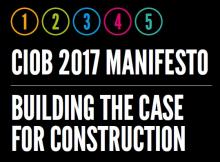CIOB 2017 manifesto
On 11 May 2017, the Chartered Institute of Building (CIOB) published their 2017 manifesto, making the case for construction ahead of the General Election.
To improve policy making and provide a better understanding of the construction industry’s contribution to society, CIOB outlined five interlinked policy proposals for prospective parliamentary candidates and the next government to consider.
Chris Blythe OBE, Chief Executive of the CIOB said:
“The quality of our built environment affects every member of society. Construction creates and maintains the places that people live, work and play, the infrastructure that supports them and the services that sustain them. And it is vital that those elected to represent their constituents in Parliament understand this.
“Our manifesto showcases how construction can act as a solution to major policy issues. Our proposals are interlinked, showcasing the need for a collaborative approach to productivity, skills, quality, investment and Brexit.
“It is crucial that policy makers appreciate the contribution of the construction sector: the decisions made today will be felt for decades and generations.”
The five aims outlined in CIOB’s Building the Case for Construction manifesto are:
- Continue support for the Industrial Strategy and recognise construction’s role in improving productivity.
- Work alongside the construction industry to support a robust system for training and skills development.
- Recognise and address both the opportunities and risks that Brexit will bring.
- Ensure quality is at the heart of the nation’s construction programme.
- Focus on regional investment in construction to rebalance the UK economy.
CIOB will be communicating with prospective parliamentary candidates, urging them to consider the importance of the built environment both at a local and national level.
CIOB has also published a series of articles under the ‘Building the Case for Construction’ banner. This contains a number of resources including an overview of the timetables for the 2017 election and a series of questions for CIOB members and non-members to ask prospective parliamentary candidates.
The full manifesto can be accessed here.
--CIOB
[edit] Find out more
[edit] Related articles on Designing Buildings Wiki
Featured articles and news
RTPI leader to become new CIOB Chief Executive Officer
Dr Victoria Hills MRTPI, FICE to take over after Caroline Gumble’s departure.
Social and affordable housing, a long term plan for delivery
The “Delivering a Decade of Renewal for Social and Affordable Housing” strategy sets out future path.
A change to adoptive architecture
Effects of global weather warming on architectural detailing, material choice and human interaction.
The proposed publicly owned and backed subsidiary of Homes England, to facilitate new homes.
How big is the problem and what can we do to mitigate the effects?
Overheating guidance and tools for building designers
A number of cool guides to help with the heat.
The UK's Modern Industrial Strategy: A 10 year plan
Previous consultation criticism, current key elements and general support with some persisting reservations.
Building Safety Regulator reforms
New roles, new staff and a new fast track service pave the way for a single construction regulator.
Architectural Technologist CPDs and Communications
CIAT CPD… and how you can do it!
Cooling centres and cool spaces
Managing extreme heat in cities by directing the public to places for heat stress relief and water sources.
Winter gardens: A brief history and warm variations
Extending the season with glass in different forms and terms.
Restoring Great Yarmouth's Winter Gardens
Transforming one of the least sustainable constructions imaginable.
Construction Skills Mission Board launch sector drive
Newly formed government and industry collaboration set strategy for recruiting an additional 100,000 construction workers a year.
New Architects Code comes into effect in September 2025
ARB Architects Code of Conduct and Practice available with ongoing consultation regarding guidance.
Welsh Skills Body (Medr) launches ambitious plan
The new skills body brings together funding and regulation of tertiary education and research for the devolved nation.
Paul Gandy FCIOB announced as next CIOB President
Former Tilbury Douglas CEO takes helm.
UK Infrastructure: A 10 Year Strategy. In brief with reactions
With the National Infrastructure and Service Transformation Authority (NISTA).
























